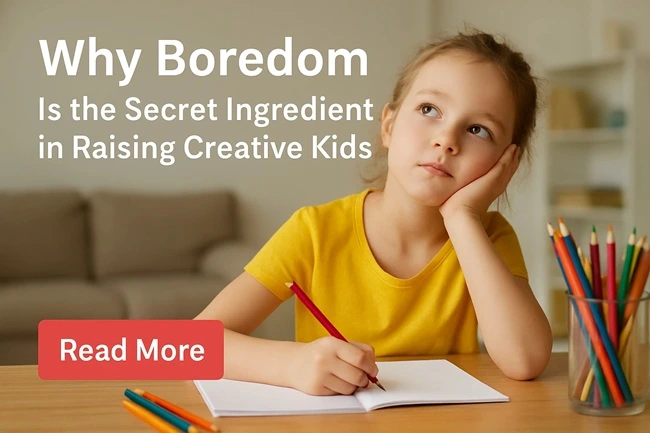“I’m bored!”—two little words that can send parents scrambling for the iPad, a new toy, or a quick distraction. But what if boredom isn’t the enemy we think it is? What if it’s actually a hidden gift, a secret ingredient that helps children grow into more creative, resilient, and independent individuals?
In today’s fast paced, screen saturated world, many parents believe they need to fill every moment of their child’s day with structured activities or digital entertainment. Yet, experts and psychologists suggest the opposite and they suggest that boredom is not a problem, it’s an opportunity.
This article explores why boredom matters, how it helps in raising creative kids, and practical ways to embrace it in parenting. If you’ve ever wondered how to raise imaginative and resourceful kids, here’s the surprising answer, sometimes, the best thing you can do is… nothing.

The Science Behind Boredom and Creative Kids
When a child has nothing to do, their brain actually becomes more active in certain ways. Researchers have found that boredom activates the default mode network, a part of the brain linked to imagination, problem-solving, and self-reflection.
- A University of Central Lancashire study discovered that bored participants came up with more creative solutions to problems than those who were constantly busy.
- Developmental psychologists say boredom allows children to “look inward,” tapping into their imagination to invent new games, ideas, or stories.
In short: downtime fuels creativity. It’s during those “nothing to do” moments that kids learn to dream, build, and create.
How Boredom Benefits Children
1. Boosts Creativity
When kids aren’t handed readymade entertainment, they invent their own. A cardboard box becomes a spaceship, a bedsheet becomes a fort, and a stick turns into a magic wand. This kind of imaginative play builds creative thinking that carries into adulthood.
2. Builds Problem Solving Skills
A bored child learns to use available resources. They figure out new ways to entertain themselves, building flexibility and resilience. This ability to “make do” is a powerful life skill.
3. Encourages Independence
Constantly entertaining kids teaches them dependence. Allowing boredom, however, gives them the chance to self manage and take charge of their own playtime.
4. Improves Emotional Regulation
Kids accustomed to non stop stimulation can become restless or anxious without it. Boredom helps them practice patience, self-soothing, and mindfulness.
5. Strengthens Resilience
Life isn’t always exciting. Teaching children to handle boredom prepares them for real world situations where they need to cope with waiting, stillness, or repetitive tasks.
Why Parents Fear Boredom (and Why They Shouldn’t)
Modern parenting often comes with guilt. We fear that if kids are bored, we’re failing as parents. There’s also the cultural pressure to keep children “productive” with sports, classes, and extracurriculars.
But the truth is, over scheduled kids may actually lack creativity and problem solving skills. By filling every gap, we rob them of the opportunity to discover who they are and what they love.
Next time your child says “I’m bored,” remember, boredom isn’t wasted time, It’s a spark waiting to be lit.
Practical Ways to Use Boredom as a Parenting Tool
1. The “Boredom Jar” Trick
Fill a jar with slips of paper that have creative activities written on them:
- “Build a fort with blankets.”
- “Draw an imaginary animal.”
- “Write a short story about today.”
- “Create a dance routine.”
When your child complains of boredom, let them pick a slip. The choice gives them control while still sparking creativity.
2. Screen-Free Time Blocks
Designate certain hours of the day as screen free zones. At first, kids may resist, but soon they’ll invent offline activities like reading, drawing, or simply daydreaming.
3. Encourage Open-Ended Play
Choose toys that don’t have a fixed purpose like Lego, blocks, playdough, art supplies. These tools allow kids to invent games rather than follow strict rules.
4. Nature as a Playground
The outdoors is the ultimate boredom buster. Collecting rocks, climbing trees, or cloud watching encourages exploration and creativity without expensive gadgets.
5. Model Downtime Yourself
Children imitate adults. If they see you scrolling your phone every free moment, they’ll do the same. Show them that downtime can mean reading a book, gardening, or sketching.
Real-Life Examples
- Age 3–6: Give crayons and paper, then ask, “Can you draw something that doesn’t exist?”
- Age 7–10: Challenge them to create a play or story using only items from the kitchen.
- Age 11–15: Ask them to design a family board game or plan a weekend outing.
Striking the Right Balance
While boredom is healthy, balance is key. Too much structure leaves kids burnt out; too much freedom leaves them directionless.
A good rule of thumb: 60% structured activities, 40% free time. This way, children enjoy both guidance and independence.
Common Mistakes Parents Make
- Rescuing too quickly: Jumping in to entertain every time they’re bored.
- Defaulting to screens: Using TV or tablets as a boredom cure.
- Criticizing their ideas: Even silly play has value. Don’t dismiss their creativity.
Long-Term Benefits of Letting Kids Be Bored
- Stronger creative thinking.
- Better problem solving skills.
- Higher emotional resilience.
- Greater independence.
- Lifelong ability to self-entertain without relying on external stimulation.
Conclusion
Boredom isn’t a curse, it’s a canvas. When children experience downtime, they stretch their imagination, learn to problem solve, and grow emotionally stronger.
As parents, our role isn’t to erase boredom but to guide children in turning it into growth.
So the next time your child says, “I’m bored,” don’t rush to fill the silence. Instead, smile and reply:
“Perfect. Now let’s see what your imagination can do.”

Hi, I’m Prashant Jain — a curious soul, storyteller, and content creator at heart.I’ve always been drawn to the world of entertainment, travel, sports, health & lifestyle — not just as a writer, but as someone who genuinely lives these experiences. Whether I’m binge-watching the latest OTT series, exploring offbeat spiritual destinations in India, or diving deep into wellness routines and cricket match insights, I love sharing what I discover with like-minded readers.
PopNewsBlend is my way of blending personal journeys with meaningful stories — ones that inform, inspire, and keep you ahead of the curve. Everything I write comes from real observations, hands-on experiences, and a deep passion for understanding the world around us.
Discover more from Popnewsblend
Subscribe to get the latest posts sent to your email.







